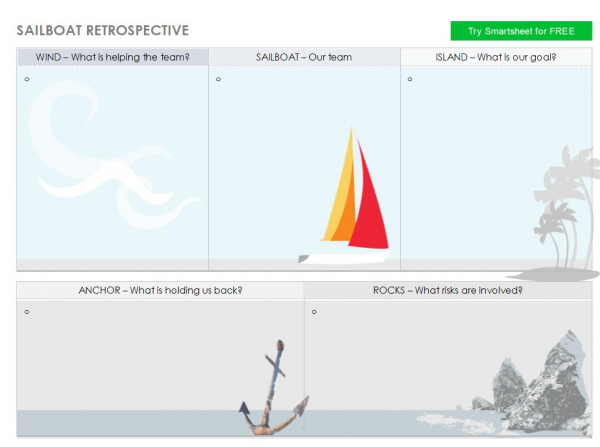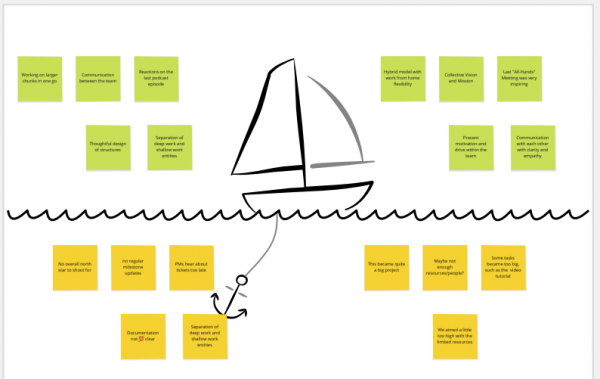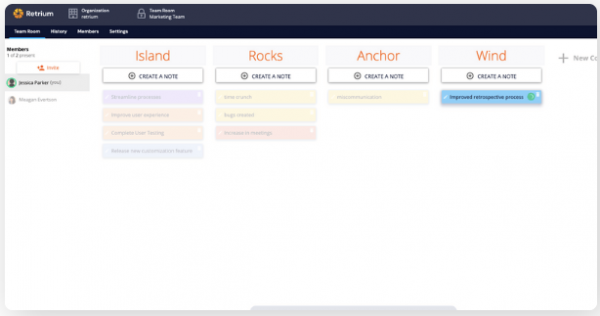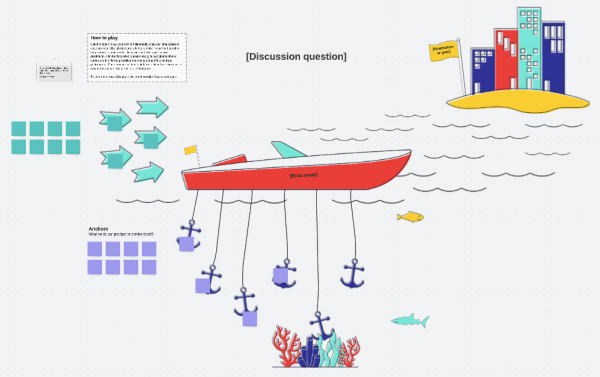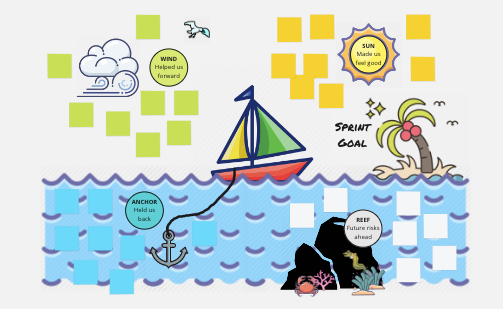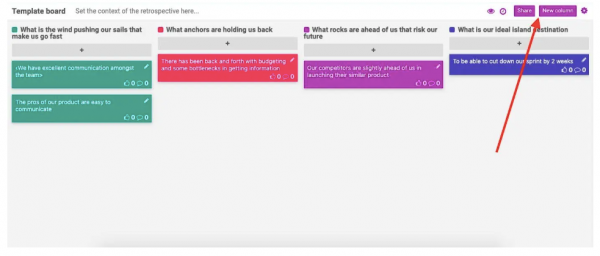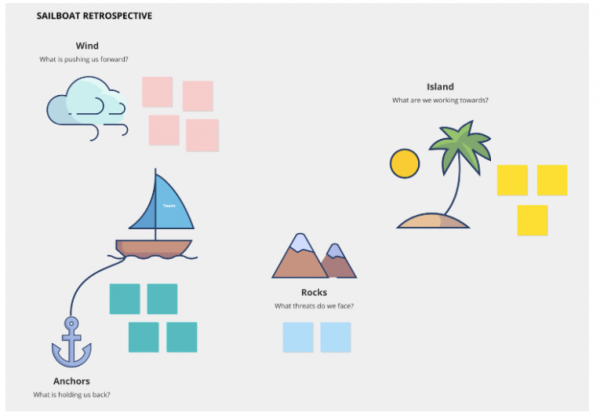Sailboat retrospective template is a retrospective technique for agile teams. It is a metaphor for looking back on a sprint and identifying what went well and what can be improved upon.
The sailboat is a symbol of forward momentum. The bow (front) of the sailboat represents what went well during the sprint, and the stern (rear) represents what can be improved.
The Sailboat Technique helps teams identify areas of improvement and take corrective action. They might also discuss any challenges they faced and identify ways to overcome them in the future.
The goal of the retrospective would be to improve the team’s performance and efficiency in future sailing endeavours.
This technique can be used at the end of each sprint to help the team reflect on their progress and identify areas of improvement.
It is a simple, effective way to help teams continuously improve their process and delivery.
The purpose of the retrospective is to reflect on what has happened during the project or time period and identify areas for improvement.
Sailboat Retrospective Explained
We should consider the following terms could potentially refer to various aspects of the sailing experience, such as challenges, obstacles, opportunities, or success factors.
Rock
For example, “rock” might refer to a problem or issue that has caused difficulty for the team. Like potential risks or different obstacles, your team may encounter.
Anchor
It refers to things that have weighed the team down or hindered their progress. For example, a boat cannot move because an anchor is holding it back. Just like how some problems, delays or any other issues are making your team not to move forward the land
Wind
This refers to the factors that have influenced the team’s performance to move on in their sprint. The wind is an ally that has helped you reach the desired destination. Basically, this represents what went well during your sprint
Land
This one refers to the team’s goals or destination which can be short or long-term but that depends on the overall of what requirements are.
Sailboat Retrospective Templates Word
Steps for Sailboat Retrospective
Conducting a sailboat retrospective is similar to conducting a retrospective in any other setting. Here is a general outline for the process:
Set the stage
Create a comfortable and focused environment for the retrospective. This could include finding a quiet space to hold the meeting and providing any necessary materials or refreshments.
Gather data
Collect information about the sailing excursion or competition that you want to reflect on. This might include logs, charts, reports, or other relevant documents.
Generate insights
Review the data and identify patterns, trends, and areas for improvement. You might want to consider using techniques like root cause analysis or the five whys to help you dig deeper into the issues.
Decide what to do
As a team, decide on specific actions that you can take to address the issues that you have identified. These might include changes to processes, training, communication, or other areas.
Close the retrospective
Thank team members for their participation and review any action items that were identified. Make sure that everyone is clear on their roles and responsibilities moving forward.
It’s also important to remember that a retrospective is not a blame game. The goal is to identify areas for improvement, not to assign blame for any mistakes that may have been made.
Free Sailboat Retrospective Templates PDF
Tips for Sailboat Retrospective in Agile
There are a number of different retrospective formats that can be used, but the sailboat format is a great option for teams who want to keep their retrospectives focused, participatory, and data-driven.
The following are the best 5 practices to follow when conducting a sailboat retrospective:
1. Keep the focus on the team and the sprint, not on individual performance.
A retrospective should be a time for the team to reflect on their experiences and identify areas for improvement. It’s important to stay focused on this goal and not let the meeting become bogged down in unrelated topics.
2. Encourage everyone to participate.
A retrospective is a team-based activity and it’s important to encourage everyone to participate. This might involve asking open-ended questions or using techniques like brainstorming to encourage idea-sharing.
3. Be data driven
Gather data about the sailing excursion or competition and use it to identify patterns, trends, and areas for improvement. This might include logs, charts, reports, or other relevant documents.
4. Keep it positive and look for ways to improve
A retrospective is not a blame game. The goal is to identify areas for improvement, not to assign blame for any mistakes that may have been made. It’s important to keep the tone of the meeting positive and focused on finding solutions.
5. Follow up on action items
Make sure that any actions that are identified during the retrospective are clearly assigned and followed up on. This will help to ensure that the team is able to make progress and improve over time.
Following these practices will help ensure that your retrospectives are productive and actionable and that the team is always moving forward.
Sailboat Retrospective Online
Why do Sailboat Retro Technique?
The sailboat retrospective is effective because it forces team members to reflect on their work, identify areas for improvement, and be accountable for their performance. Additionally, the retrospective provides an opportunity for team members to collaborate and learn from each other.
Reflection
A retrospective provides an opportunity for team members to reflect on their experiences and identify areas for improvement. This can help to identify and address any issues that may have been overlooked during the sailing excursion or competition.
Continuous improvement
By regularly reviewing and analyzing data and identifying areas for improvement, the sailboat retrospective helps to encourage a culture of continuous improvement. This can help the team to become more efficient and effective over time.
Collaboration
The retrospective is a team-based activity that encourages collaboration and idea-sharing. This can help to build trust and improve communication within the team.
Accountability
By identifying specific actions and assigning responsibilities during the retrospective, team members are held accountable for making the necessary changes to improve performance.
The retrospective is based on the following four principles:
- We are all responsible for our own success or failure
- We can always improve
- We need to be able to learn from our mistakes
- We need to be accountable for our actions
The Sailboat Retrospective is a simple and effective way for teams to reflect on their work, identify areas for improvement, and take action to improve their performance.
Other Retrospective Ideas


Sailboat Retrospective FAQs
What is a Sailboat Retrospective?
The Sailboat Technique is a simple yet effective way to get everyone on the team to share their thoughts and ideas about what went well during the sprint and what could be improved. It is a great way to help team members identify areas where they need to work together more effectively.
Why is the sailboat retrospective effective?
A sailboat retrospective is a powerful tool for team improvement. It helps teams identify and track their progress, and provides a way for teams to hold themselves accountable for their results. This type of retrospective can be used by teams of all sizes and levels of experience.
What does the island represent in the sailboat retrospective?
The island in the sailboat retrospective is a symbol of the company’s objective, goal, or vision. It represents where the company is going and what it wants to achieve. The island is also a metaphor for the challenges and obstacles that the company will face along the way.
What do anchors represent in the sailboat Retrospective?
The anchors refer to issues or problems that have weighed the team down or hindered their progress. These could be challenges that the team faced during the sailing excursion or competition, or areas where they feel they could have performed better.

